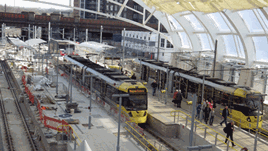On July 29, Lord Ahmad of Wimbledon (the Government’s transport spokesman in the Lords) told Lord Greaves in a Written Reply: “The pause in the electrification of trans-Pennine and the Midland Main Line will have no impact on the ending of the use of Pacer vehicles on the Northern franchise by 2020, or the terms and conditions relating to the re-letting of the Northern franchise.”
Detailed conversations are also being held with HS2 Ltd as to what Manchester needs to best exploit HS2’s potential. Says White: “Now we have HS2, Network Rail and the other interested bodies sitting round the same table, talking not just about what we want for 2040, but also how short-term developments will fit into the Long-Term Planning Process.”
In this more collaborative way of working and planning, even HS3 is being developed, in how it will interface with HS2 and what the train services might look like.
Nevertheless, while TfGM is intimately involved with long-term plans for franchises and high-speed rail, its main rail-related remit remains to look after the local rail services within its boundaries.
The potential for developing and improving these services under the new franchises is now far greater than it has been over the past 20 years. White says that TfGM has recently commissioned an Urban Rail Study that will consider future Metrolink and tram-train developments, as well as heavy rail services.
When the DfT announced its British tram-train trial in March 2008, to be carried out on the Huddersfield-Penistone-Sheffield line, Greater Manchester was one of the first to express serious interest in operating such vehicles in its area. Indeed, the 1983 Rail Strategy for Greater Manchester study indicates the potential for converting the lines to Glossop and Rose Hill to light rail use.
In 2008, Manchester could realistically have anticipated that such services would be under way by now. Instead, the trial has been long delayed, and it is likely to be the early 2020s before tram-train vehicles arrive in the UK.
Thus the forthcoming Urban Rail Study will consider Light Rapid Transit across Greater Manchester in some detail, and evaluate whether the long-standing proposals for tram-train might (for example) actually be best served by developing a bus rapid transit solution.
“More transport infrastructure is certainly going to be needed to cater for Manchester’s growth, and it does make sense to link local rail services into the Metrolink network, thus releasing capacity at Piccadilly station,” says White.
The powers being devolved to Greater Manchester cover buses, roads and rail, as well as some non-transport topics. In rail, TfGM is looking at taking over the leases of the 97 railway stations in the area, so as to be able to improve their condition (particularly with regard to accessibility) and exploit their commercial potential to the benefit of the local communities.
“There is quite a lot of room for improvement, and we want to see much better integration between all modes of transport at railway stations,” says White.
“If we can improve our stations so they provide a much, much better facility for the community, and have a consistent quality and brand with a high level of customer service, then we think there’s a lot of opportunity to be had there.”
Irlam station, where private investment has provided new facilities, is considered a particularly good example of what can be achieved.
At present, Network Rail leases nearly all of Britain’s stations to the relevant train operator on leases that last only as long as the franchise. But TfGM hopes to be able to take on 99-year leases, so as to give plenty of time for private sector investments to be developed and a proper return made.
The Strategy consultation document wraps up all these challenges: “The local network needs to be connected with HS2 services, new inter-city and regional services, tram services and expanded park and ride facilities.
“This requires building on existing commitments to provide more electrification, new rolling stock as a matter of urgency, higher rail service frequencies, new services, gauge improvements and the removal of network pinch points, as well as integrated ticketing and seamless travel.”
The railway’s fortunes have changed in the past few years, and with Greater Manchester’s ambitions undiminished, nowhere in the UK has such major and varied developments firmly in its sights. The vision document can be downloaded via the TfGM website at www.tfgm.com/2040.
- This feature was published in RAIL 782 (September 2 - 15 2015)















Login to comment
Comments
No comments have been made yet.